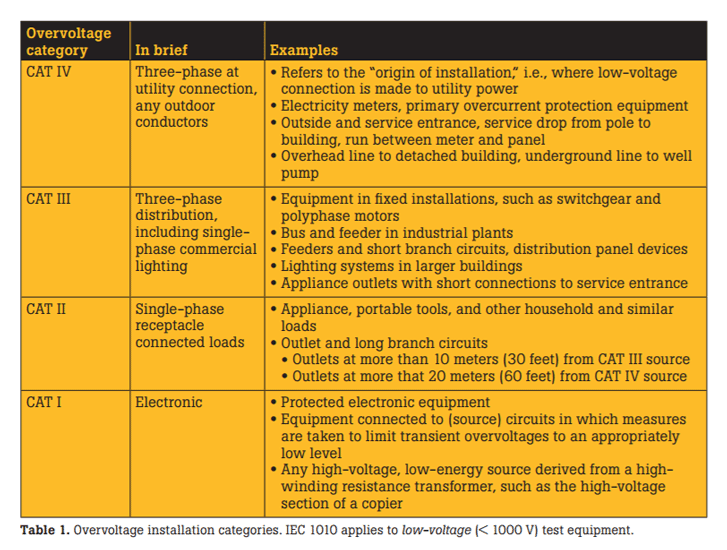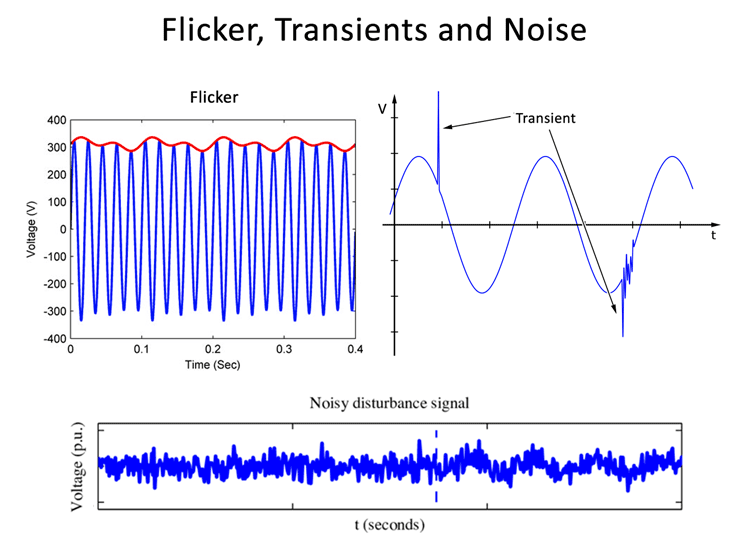Flicker, transients, and noise examples. Photo: Various Sources.
Transients are defined as temporary unwanted voltage fluctuations in an electrical circuit that range from a few volts to several thousand volts and last anywhere from a few micro seconds up to a few milliseconds. To protect technicians from injury, test equipment must be designed to withstand this spike in voltage by means of added insulation.
The IEC (International Electrotechnical Commission) specifies categories of overvoltage in the IEC-1010-1 standard. Each installation category is based on the distance from the power source and natural damping of transient energy that occurs in an electrical distribution system.
This standard is the basis for several other national standards such as UL 3111 and ANSI/ISA-S82.01-94 in the United States, and CAN C22.2 No.1010.1-92 in Canada. Higher level categories are closer to the utility power source and require more protection than lower level categories further down the line.
IEC Overvoltage Definitions
Personal safety is of the greatest concern when measuring high voltage. By knowing these important IEC definitions, you will have a better understanding of installation ratings and the level of transient voltage that your test equipment can handle.

Multimeter overvoltage installation categories. Photo: Fluke.
Test equipment intended to measure the voltage levels of electrical loads (< 1000V) must be rated at these overvoltage categories.
Category IV - Primary Supply Level
Refers to the “origin of installation,” such as where low voltage connections are made to overhead utility power. These devices can handle the largest transients relative to the nominal system operating voltage. Examples include electricity meters, primary overcurrent protection equipment, and service drops.
Category III - Distribution Level
Suitable for three-phase distribution, including single-phase commercial lighting. Refers to fixed installations, such as switchgear and motors where the reliability and the availability of the equipment is subject to special requirements. May also apply to appliance outlets with short connections to service entrance.
Category II - Local Level
Refers to energy-consuming equipment supplied from fixed installations. Some examples include general appliances, portable tools, and other similar loads.
Category I - Signal Level
For connection to circuits where precautions are taken to limit transient over-voltages to an appropriately low level. These devices can handle only small transients, such as those in protected electronic circuits. Also applies to any high-voltage, low-energy source derived from a high-winding resistance transformer.

IEC Transient Voltage Tolerance by Category
Insulation Types
In addition to defining installation categories, IEC 1010 specifies the level of insulation required to create an isolation barrier from transients.
Basic Insulation
The amount of electrical insulation required to create an isolation barrier. If a breakdown in the insulation could cause dangerous current to flow through a human body, basic insulation is not enough safety protection.
Double insulation
Basic insulation plus a form of supplementary insulation (for example, another basic layer). If the basic insulation breaks down (single fault), the supplementary insulation keeps the user safe.
Double insulation protects from an electrical shock by preventing any possibility of the enclosure from becoming live (the live wire can not touch the enclosure in the event wires become loose inside the equipment), thus eliminating the need for an earth connection.
Reinforced insulation
Serves the same purpose as double insulation except that the two insulation layers cannot be tested separately.

